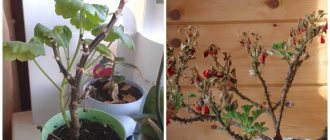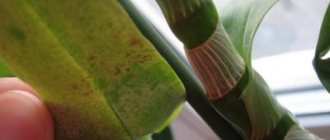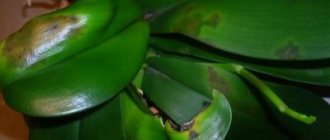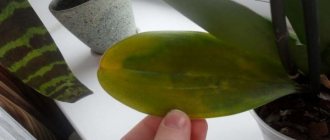Orchids are epiphytic plants that live in nature on the trunks and branches of trees. Their roots absorb water from the air, and mineral elements come from rotted plant remains.
If indoor conditions are far from natural, the orchid begins to have problems with its roots .
The pathogenic process proceeds slowly , therefore, if diseased roots can be identified, the orchid can be saved. In this article you will learn what to do if the orchid roots turn yellow.
Yellow roots of an orchid are a consequence of uncomfortable maintenance of the plant
This can happen in a number of cases:
- the plant was planted too deep in the substrate;
- put the pot in a dark place;
- uncomfortable conditions for keeping the flower .
Important. Leaf damage occurs especially quickly when abundant watering is combined with low air temperature in the place where the orchid is kept.
To avoid diseases of the root system, the orchid should be planted in a transparent container filled with a hygroscopic substrate.
How to distinguish a healthy flower from a sick one?
In order to understand whether there are problems with the roots or not, you should pay attention to the appearance of the plant.
- Condition of foliage . When the root system rots, the surface of the leaf turns yellow, dark spots appear on it, and soon die off one by one.
- Duration of flowering . The buds fall off, a flower with diseased roots is unable to nourish them.
- Persistence in a pot . If the orchid leans to one side, sits loosely in the pot, or loses its balance, it means the roots have weakened.
If such signs are detected, you should remove the plant from the pot and inspect the roots. Dry root shoots, indeed, do not provide any benefit to the plant. But determining whether this shoot is alive or not is sometimes difficult even for experienced flower growers. They differ:
- By color . Healthy rhizomes are light to dark green in color. Dry, rotten roots are pale yellow, brown, black.
- By structure . Living roots are thick, smooth, dense. The damaged areas are soft, loose, crushed with a finger, and liquid flows out of them.
Advice! To make sure that the root system is alive, you should remove the plant from the pot and place it in water for a couple of hours. Healthy parts will take on the appearance described above. Feel free to remove dry, flaccid, pale shoots.
Why do the roots turn yellow?
The reasons that cause the appearance of yellowed roots can be different:
- soil quality . A dense or poor-quality substrate prevents air circulation and creates conditions for oxygen starvation of the roots. It also promotes the development of pathogens;
- improper watering . Excessive watering or too frequent moistening leads to stagnation of water and rotting of the roots;
- lighting. An orchid needs a lot of diffused light, so in the autumn-winter period it is better to illuminate the plant with a phytolamp. A lack of light reduces the orchid's immunity, making it more susceptible to diseases, including fungal infections.
- Pot size is too large. A large pot volume increases the likelihood of water stagnation; in this case, it is difficult to correctly assess the degree of drying of the substrate.
If rotting of the roots of the system is not detected in time, this can lead to the death of the plant .
Main causes of rotting
In an orchid, like in all epiphytes, the root system is built in such a way that the flower does not absorb water and nutrients through small roots. All nutrition occurs through the spongy part of the rhizome. If this process fails, the orchid begins to hurt.
Another reason for rot is compacted soil that has not been changed for a long time. It becomes heavy and dense. The water begins to stagnate, and the root system rots. To prevent this from happening, the soil for growing is prepared independently from disinfected pine bark and sphagnum moss. A lack of sunlight can also provoke rotting. Some of the moisture does not evaporate and is not absorbed, which negatively affects the condition of the root system.
Popular: What to do if the leaves of the calathea begin to turn yellow
It can rot due to improper feeding of the orchid. Roots easily get burned when using phosphorus and potassium compounds. The orchid receives similar damage due to careless transplantation. An infection gets into the “wound”, weakening the plant. Pests, such as click beetles, can feed on the roots of the flower. The trigger is waterlogging of the substrate in winter and autumn. Flower growers do not always regulate the intensity of watering in different seasons.
What to do if the roots turn yellow but are elastic?
The reasons for the appearance of yellowness at the roots are different, and further actions that need to be taken depend on this.
First aid
If the yellow roots of the orchid have retained their elasticity and are hard to the touch, this is a sign of their vitality. In this case, the roots are not cut; it is enough to adjust the care and rules for maintaining the flower:
- the root system is carefully inspected so as not to miss a rotten area;
- if the roots or a section of the root are pressed through when pressed with a fingernail, the root is cut off to healthy tissue.
A timely diagnosis will allow you to save the plant.
The Importance of the Root System
The roots of the epiphyte orchid are very important organs because they perform many functions.
- First of all, thanks to them, orchids are kept in an upright position.
- Secondly, they participate in photosynthesis, just like the leaf surface.
- Thirdly, roots are needed to absorb moisture and extract nutrients, the source of which is the air and the bark of the trees on which orchids live.
Another, smaller part of orchids are lithophytes that grow on rocky and stony rocks. Just by looking at the roots of an orchid, you can accurately determine the health status of the plant. The roots of the orchid, both aerial and internal, must be healthy in appearance: strong, dense, without signs of rot, without dark spots and not dry.
This rule applies both to phalaenopsis, whose roots are green, and to cattleyas and dendrobiums, whose roots are mostly white, with the exception of the growing green tip.
Reference! A feature of epiphytic plants is their root system covered with velamen. Velamen are dead hygroscopic cells that form thick layers. Velamen absorbs and temporarily retains moisture.
Rainwater that flows over the surface of trees washes away and dissolves the remains of organic matter - half-decomposed leaves, as well as traces of the activity of birds and insects. In this way, a nutrient solution is formed, which is absorbed and retained by velamen. Hygroscopic velamen collects moisture from the air, becoming saturated with water vapor. Fog and dew provide the orchid with moisture during dry periods. Velamen also protects the orchid roots from drying out.
In order to collect the required amount of moisture, these plants need a large absorbent root surface, so the orchid forms “beards” of aerial roots hanging from tree branches. With the help of roots, orchids are securely attached to the rough surfaces of the bark.
If the root is hard and elastic, this is a sign of its viability. At the same time, if the root looks healthy, but when pressed it is easily pressed, it is most likely that it is dead. It happens that a generally healthy root has a necrotic area somewhere in one place. Such a root is no longer useful to the plant, because it is not able to fully nourish it, and can even cause harm: a dead area can become a source of infection for the orchid stems.
The roots are yellow and soft - a sign of rotting. How to treat?
Yellow plaque can be caused by bacterial or fungal rot; such a plant needs urgent treatment .
Fungal diseases of the root system are often accompanied by the formation of yellow mold on the roots , the appearance of yellow balls (mycelium plexus) and plaque. If these signs are detected, as well as in the case of bacterial infections of the roots:
- the orchid is removed from the soil , the roots are washed with warm water;
- use a disinfected instrument to remove all unhealthy roots ;
- the sections are rubbed with crushed activated carbon;
- if affected by fungi, the root system is soaked in a solution of 0.2% Fundazol solution for 15 minutes;
- if the roots are affected by bacterial rot, they are treated with copper-based bactericidal preparations - copper hydroxide (CuOH), copper peroxide (CuO2) or Bordeaux mixture.
Crystalline copper acts as a mechanical barrier, preventing the spread of disease along the root surface.
Attention. Treatment of the roots can be carried out by immersing the pot in water with a dissolved preparation.
To consolidate the positive effect, the procedure is carried out three times with an interval of 10-14 days . Then the plant is transplanted into a new substrate and a new pot and optimal conditions are created.
How to gradually revive a purchased flower that is dying?
How to save an orchid if all its roots are rotten, whether this can be done, and what to do for this, is discussed further. Even if the root system is completely rotten, the plant can be saved. First of all, it is necessary to remove the diseased roots. This is done in several stages.
Substrate removal
- To remove the substrate, the orchid is pulled out of the pot.
- Gently shake the plant until large lumps fall off.
- Residues are removed with water.
Washing the underground part
Before the procedure, the roots are placed in a bowl of water for 10-15 minutes. After this, you can begin the final removal of the substrate:
- The orchid is taken by the stem so that the roots remain in the basin.
- The fingers of the second hand are placed between the roots and gently moved, slightly pushing the woven roots apart.
- Shower off small pieces. To do this, you need to adjust the pressure of the stream so that it does not tear the roots, but cleans off the dirt.
After washing, some roots may still have some substrate left. It cannot be cleaned off by hand. Anything that is not removed with a stream of water is left behind.
Removing diseased roots
What to do with rotting roots? All rotten roots are removed with garden shears or a sharp knife:
- The cut is made on living tissue, at least 3 cm above the lesion site.
- After pruning, the orchid is left in the air for at least 2-3 hours so that the damaged areas heal.
- The dried wound is treated with crushed activated carbon, wood ash or ground cinnamon. This will prevent infection from entering the damaged areas.
After pruning, the orchid can be immediately revived in a greenhouse or in other ways, but it is better to use additional treatment first.
Treatment with growth stimulants
Rotting is always associated with the appearance of a fungus, so before planting, the roots are treated twice, with a week's break. Can be used:
- Tolclofosmethyl.
- Boscalid.
- Pencycuron.
Additionally, succinic acid is added to the solution with each soaking, Epin or Zircon - once every 2-3 weeks.
While antifungal treatment is being carried out, the flower is not planted in the substrate. To prevent the root system from drying out, it is periodically sprayed with a spray bottle. You can add succinic acid to water, 1 tablet per liter of water, it is a natural and safe growth stimulator.
When reviving without a substrate, you can combine root germination and treatment with fungicides and biostimulants.
Prevention measures
Optimal prevention of fungal and bacterial infections lies in following the rules for the care and maintenance of the orchid . When planting, you should use only high-quality soil, and:
- substrate particles should not be mixed , since smaller particles fill the gaps and reduce the size of the voids;
- The soil mixture should not be compacted too tightly.
Every two to three years the substrate is replaced with a new one . Compliance with all the rules will ensure the restoration of health and prosperity of the orchid.
Plant life cycle
Orchid is a plant native to tropical forests, where it is humid and hot . Depending on their growing area, flowers have a unique structure. The peculiarity of orchid roots is the substance velamen. It is a non-living, rough tissue filled with air.
Velamen is like a cover that envelops the roots. The functions of this substance are to absorb and retain water and nutrients. Due to the natural humid climate, there are dissolved particles of liquid in the air, which velamen absorbs and, during periods of drought, nourishes the plant.
With a lack of sunlight, the natural substance does not dry out completely; as a result of a prolonged wet state, the process of decay begins.
Attention! Another factor that affects the condition of the roots is the lack of interaction with the air.
Diseases
The orchid dries out from fungal infections; they occur with frequent watering and affect the root system and trunk of the flower. If rotting is not stopped in time, it will also affect the leaves, causing them to turn yellow and fall off. It is necessary to take immediate action - replace the substrate, trim the affected areas and treat the phalaenopsis with an antifungal drug. For prevention, use fungicides.
Due to bacterial infections, the leaves turn sharply yellow, darken over time, become limp and wrinkled, and weeping spots appear with an unpleasant smell of rot. Isolate the plant, trim off the affected areas and treat the sections with iodine. Only after treatment with an antifungal drug can the flowerpot be returned to its original place.
Types of orchids and reasons for their yellowing
Botanists count at least 30 thousand species of orchids, including hybrids. But not all of them are suitable for home cultivation, and most of these flowers grow in the wild or in greenhouses. The most unpretentious, beautifully flowering specimens are suitable for apartments: phalaenopsis, dendrobium, cattleya, paphiopedilum, cymbidium.
Beginners and experienced gardeners are often faced with the problem of yellowing, withering and falling orchid leaves. At the same time, the plant slows down its growth and stops producing new buds. There are several reasons for this phenomenon:
- improperly performed transplantation;
- excessive or insufficient watering;
- lack or excess of fertilizers;
- attack by insect pests;
- natural aging and replacement of shoots;
- lack of light;
- sunburn;
- The temperature in the room is too high.
Why does phalaenopsis turn yellow?
Phalaenopsis is one of the most popular orchids and is often found in homes. The peculiarity of this plant is its shade tolerance. Phalaenopsis feels great on northern windows, and direct sunlight can negatively affect the condition of its leaves and stems. The plant needs regular feeding with complex fertilizer for orchids and in a compact pot, where the bulb is planted without being buried. Yellowing leaves may indicate a lack of moisture, too dry air or high temperature in the room.
Causes of yellowing of dendrobium
Dendrobium is a showy plant with a garland of large flowers beautifully interspersed with narrow leaves. This type of orchid is quite picky about temperature and humidity levels. It tolerates waterlogging and drought equally poorly, does not like extreme heat and reacts negatively to drafts. The ideal microclimate for dendrobium is warm, moderately humid, stable. Yellowing of narrow, dark green leaves can be caused by direct sunlight, improper watering, or too high or low temperatures. Often the culprits of problems are pests: scale insects, aphids, spider mites.
Cymbidium: an unpretentious flower with features
Cymbidium is a beautiful flower with straight stems-peduncles strewn with large bright buds. It is distinguished by lush dark green leaves that remain decorative for a long time. For greenery to have a beautiful color, it needs bright, diffused light (backlighting is necessary in winter and autumn). Cymbidium can wither in a room with too dry air; it benefits from regular ventilation without strong drafts. It is advisable to maintain daily temperature fluctuations; at night the flower prefers coolness. In the warm season, cymbidium feels great on the balcony or veranda. Leaves and stems should be protected from mechanical damage.
Diseases of orchid leaves - how to fight?
Diseases of orchid leaves - how to fight? First you need to understand what diseases are. Diseases of orchid leaves are divided into viral, fungal and bacterial. Accordingly, they manifest themselves in different ways: in the form of stains, plaque, rot, loss of color.
Note! It is necessary to gradually accustom the orchid to the lighting in the house to avoid burns. In spring, first shade the places where orchids live to avoid weakening their immunity. Over time, this will only need to be done on the hottest summer days.
Common diseases
The most common leaf diseases are:
- Anthracnose (see photo). This is a fungal disease that attacks the leaves. It looks like small round spots of brown or almost black color. If you do nothing about the problem, over time the spots grow and connect with each other. Large affected areas form depressions, and over time a coating of yellow, white or pinkish tint appears. The cause of the disease is high indoor humidity. In addition, improper watering can also have an impact, which leads to stagnation of water in the recesses where the leaves are attached to the stem. Treatment boils down to cutting out problem areas and treating the sections with activated carbon or ash. The entire plant should be treated with preparations that contain copper. Spray three times with an interval of ten days. During the treatment period, it is advisable to cancel fertilizing and reduce watering to a minimum. Most often, the problem concerns varieties such as oncidium, paphiopedilum, phalaenopsis, and miltonia. Prevention can be achieved by maintaining the air temperature from 40% to 70%, regular ventilation, proper watering and removing moisture from the leaf axils.
- Bacterial spot (see photo). The disease often affects phalaenopsis and dendrobium plants. The leaves are the first to suffer: they turn yellow, and then darken, soften and crack. You can notice ulcers with liquid in them. Moreover, the leaves themselves become sticky. Treatment boils down to cutting out problem areas and treating them with activated carbon or iodine. Professional medications (they are stronger) should be used only in cases where the lobar vein has been damaged. In any case, treatment should be daily for 10 days. If improvements are noticeable and no relapse occurs 10-14 days after the end of treatment, the orchid is completely healthy. The disease more often manifests itself in spring and summer due to improper (excessive) watering and bright lighting.
- Powdery mildew (see photo). The presence of a white coating (the leaves appear sticky) that can be seen on both the buds and leaves of the plant indicates a problem. If nothing is done, the affected areas quickly dry out and the orchid dies. The reason is increased humidity and high temperature in the room, which leads to the so-called greenhouse effect. If you see a whitish coating, the first thing you need to do at home is to take care of proper care; most likely, you did something wrong. The orchid needs to be sprayed with “Skor” or “Topsin-M”, and a solution of colloidal sulfur also helps well. For prevention, the plant can be sprayed with Fitosporin.
- Deformation of leaves (see photo). Most often the cause is mechanical damage, but this may also indicate a disease. The reason is hypothermia after watering or excessive watering. The problem may also arise due to the use of nitrogen fertilizers in plant care. The presence of deformation can be judged by breaks, thickenings, cracks on the leaves, as well as a change in their color from natural to dark green. To get rid of the problem, replant the plants, washing the roots in advance, and discard the fertilizer.
- Leaf burn (see photo). Damage usually appears in summer and spring when sun activity is high. Remember that plants really need sufficient light, but diffused light, and direct sunlight causes burns. They usually appear due to the presence of droplets of moisture on the leaves. Burns are indicated by discolored areas with a brown edge. Over time, these areas dry out and holes form in their place. Damaged areas need to be cut out of the affected plant, the orchid should be shaded and proper watering should be ensured. Also, give up bait for a while.
- Rust (see photo). This is one of the rarest, but very dangerous and serious diseases (essentially, it is a fungus). The leaves are affected, on which light and seemingly sticky spots form. Then they turn into red areas where spores are later formed. You need to fight like this: cut out the problem areas, the cut areas need to be disinfected with an alcohol solution (20%) or with activated carbon. Additionally, an orchid at home can be sprayed with Ridomil, Topsin-M, Skor, Mikosan and other products with a similar spectrum of action.
- Black, or sooty, mushrooms (you can see what they look like in the photo). They appear due to the fact that the plant is attacked by pests - mainly aphids, mealybugs or white scale insects. The fungus appears in the stomata of leaves, weakening them. If you do nothing, the plant will die. The struggle comes down to the fact that the orchid needs to be treated with “Skor”, “Topsin-M”, “Mikosan” or “Ridomil”.
Fungus and rot
Fungus and rot in orchids are one of the most common problems that flower owners have to contend with. The reason, oddly enough, is excessive care. Keep in mind that there are different types of rot.
- Fusarium. The presence of rot is indicated by yellowed, curled and softened leaves with pinkish spots. The reason is insufficient air circulation and high humidity. Phalaenopsis, miltonia and epidendrum are very susceptible to the disease. The treatment for fusarium rot is to treat the orchid with a solution of foundationazole (0.2%) three times a day for at least 7-10 days.
- Brown bacterial. It is represented by brown spots (they appear watery) on the leaves. Most often, the disease affects young leaves. If nothing is done, the leaves will darken and grow together. The process of rotting accelerates under conditions of low temperature and abundant watering. If you have just discovered a problem, you can deal with it by cutting out the damaged areas with a sharp knife, taking a small amount of healthy leaf tissue. Sections must be treated with special preparations, which contain either crushed coal or copper. Without such manipulations, it will not be possible to save the plant. If you notice the problem too late, you will have to throw away the orchid so that the disease does not affect other flowers. Keep in mind that the problem often occurs with varieties such as cymbidium, paphiopedilum, cattleya, and phalaenopsis. As a preventative measure, you can spray the flowers monthly with a solution of copper sulfate.
- Black. Such rot appears on orchids that are grown in very cold rooms. A recent plant disease or pest attack increases the likelihood of black rot appearing. Treatment consists of removing the affected areas. Sections must be treated with either Bordeaux mixture or charcoal. Then the plant should be transplanted into a sterilized pot with a sterile substrate. It is necessary to create the proper living conditions for the flower. Most often, the disease affects Paphiopedilum and Cattleya. Prevention is only normal care, which boils down to maintaining the moisture and temperature required for a particular variety.
- Crown or core. It is a wound parasite that infects the plant and leads to its death by releasing strong toxins. Young shoots and leaves are the first to suffer, then the roots. The main manifestation of the disease is the appearance of weeping spots on the leaves, located chaotically. If left untreated, the spots turn black or brown with a purple tint. Over time, they increase in size and secrete liquid, through which healthy parts of the plant are affected. The main reason is high indoor humidity. Parts of the plant affected by the disease must be removed. Sections are treated with zineb (0.4%), copper sulfate (1%), Bordeaux mixture (1%) or tyramine. Prevention - maintaining a normal microclimate, which is comfortable for the growth of orchids.
Viral diseases
Viral diseases of orchids are also quite common. If they are detected, the plant must be removed from others and destroyed. To date, there are no effective methods to combat viruses. The biggest problem is that the virus may not manifest itself for a long time. There are no descriptions of such diseases as such. The presence of a virus can be judged by the fact that the shape and color of the plant changes. Pay attention to the photo.
The reason for the appearance of the virus is the processing of the orchid with dirty tools. If suitable conditions are present (change in environment, increase or decrease in humidity and temperature), the virus is immediately activated and infects the plant. In any case, if a virus is suspected, it is advisable to immediately remove the plant and treat it with a fungicide and any antibiotic. If there is no improvement, the plant is affected by a viral disease and, unfortunately, will have to be destroyed.
Features of caring for orchid roots
Caring for orchids is not easy even for experienced specialists who know how to properly treat the roots, taking into account the capriciousness of the plant and its needs. It is necessary to adhere to the rules of hygiene: both the soil and containers and tools must be washed and treated with a solution of potassium permanganate or appropriate chemicals.
Cutting tools must be sharp so as not to injure the roots or other parts of the plant. And the most important feature of caring for an orchid is putting your soul into the work - all manipulations are carried out carefully, carefully, and affectionately.
The root system of any plant is its “heart”. This statement is especially true for orchids. These beauties will respond to their owners' care with beautiful flowering only if their roots are in perfect order.











